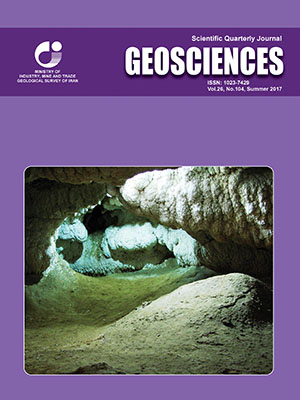References
Adabi, M. H., 2009- Multistge dolomitization of upper Jurassic mozduran formation, Kopet-Dagh Basin, n.e. Iran. Carbonates and Evaporites 24:16-32.
Adabi, M. H., Salehi, M. A. and Ghabeishavi, A., 2010- Depositional environment, sequence stratigraphy and geochemistry of Lower Cretaceous carbonates (Fahliyan Formation), south-west Iran. Asian Earth Sciences 39: 148–160.
Ahmad, A. H. M., Bhat, G. M. and Haris Azim Khan, M., 2006- Depositional environments and diagenesis of the kuldhar and keera dome carbonates (Late Bathonian-Early Callovian) of Western India. Asian Earth Sciences 27: 765-778.
Alavi, M., 2004- Regional stratigraphy of the Zagros fold-thrust belt of Iran and its proforeland evolution. American Science 304: 1–20.
Amodio, S., 2006- Foraminifera diversity changes and paleoenvironmental analysis:the Lower Cretaceous shallow-water carbonates of San Lorenzello, Campanian Apennines, southern Italy. Facies 52:53-67.
Bachmann, M. and Hirsch, F., 2006- Lower Cretaceous carbonate platform of the eastern Levant (Galilee and the Golan Heights): stratigraphy and second-order sea-level change. Cretaceous Research 27:487-512.
Bathurst, R. G. C., 1975ـ Carbonate Sediments and their Diagenesis, Developments in Sedimentology, Elsevier, Amsterdam, 658 pp.
Burchette, T. P. and Wright, V. P., 1992- Carbonate ramp depositional system. Sedimentary Geology 79: 3-57.
Cadjenovic, D., Kilibarda, Z. and Radulovic, N., 2008- Triassic to Late Jurassic evolution of the Adriatic carbonate platform and Budva Basin, Southern Montenegra. Sedimentary Geology 24: 1-17.
Coe, A. L., 2003- The sedimentary record of sea level change. The Open University, Cambridge University press, 287pp.
Dunham, R. J., 1962- Classification of carbonate rocks according to depositional texture In: Ham, W.E. Classification of carbonate rocks.American Association of Petroleum Geologists 1, 108–121.
Embry, A. F. and Klovan, J. E., 1971- A Late Devonian reef tract on northeastern Banks Island, NWT, Bulletin of Canadian Petroleum Geology19: 730 – 781.
Flugel, E., 2010- Microfacies of Carbonate Rocks: Analysis, Interpretation and Application, second ed. SpringerـVerlag, Berlin, 984pp.
Green, M. A., Aller, R. C. and Aller, J. Y., 1992- Experimental evaluation of the influences of biogenic reworking on carbonate preservation in nearshore sediments. Marine Geology 107: 175-18.
Hosseini, S. A., Conrad, M. and Kindler, P., 2013- Iranella inopinata Gollestaneh 1965, a puzzling dasycladalean alga from the Lower Cretaceous shallow carbonate shelf deposits of the Zagros fold-thrust belt, SW Iran. Facies 59:231–245.
Jamalian, M. and Adabi, M. H., 2015- Geochemistry, microfacies and diagenetic evidences for original aragonite mineralogy and open diagenetic system of Lower Cretaceous carbonates Fahliyan Formation (Kuh-e Siah area, Zagros Basin, South Iran). Carbonates and Evaporites 30:77–98.
Jamalian, M., Adabi, M. H., Moussavi, M. R., Sadeghi, A., Baghbani, D. and Ariyafar, B., 2011- Facies characteristic and paleoenvironmental reconstruction of the Fahliyan Formation, Lower Cretaceous, in the Kuh-e Siah area, Zagros Basin, southern Iran. Facies 57:101–122.
James, G. A. and Wynd, J. G., 1965- Stratigraphic nomenclature of Iranian oil consortium agreement area. American Association of Petroleum Geologists Bulletin, 49, 2182-2245.
Khalifa, M. A., 2005- Lithofacies, diagenesis and cyclicity of the ‘Lower Member’ of the Khuff Formation (Late Permian), Al Qasim Province, Saudi Arabia. Asian Earth Sciences 25: 719–734.
Koch, R., Moussavian, E., Ogorelec, B., Skaberne, D. I. and Bucur, I., 2002- Development of a Lithocodium (syn.Bacinella irregularis)-reefmound-apatch reef within middle Aptian lagonal limestone sequence near Nova Gorica (SabotinMountain, W-Slovenia). Geologija 45: 71-90.
Libelo, E. L., Macintyre, W. G., Seitz, R. D. and Libelo, L. F., 1994- Cycling of water through the sedimentـwater interface by passive ventilation of relict biological structures. Marine Geology: 120, 1ـ12.
Maleki, S. and Lasemi, Y., 2011- Sedimentary Environment Sequence Stratigraphy of the Fahliyan Formation in Assaluyeh (Bidkhon) and Khartang Sections, Southwest Iran. Basic and Applied Scientific Research12:2641-2647.
Moore, C. H., 2001- Carbonate reservoir porosity evolution and diagenesis in a sequence stratigraphic framework. Elsevier, Amsterdam,444 pp.
Pittet, B., Van Bachman, F., Hillgartner, H., Razzin, P., Grotsch, J. and Drostes, H., 2002- Ecological succestion, paleoenvironmantal change, and depositional sequences of Barremian- Aptian Shallow- Water carbonates in northern Oman: Sedimentology 49: 555-581.
Sadooni, F. N., 1997- Stratigraphy and petroleum prospects of Upper Jurassic carbonates in Iraq. Petroleum Geoscience 3:233–243.
Sahraeyan, M., Bahrami, M., Hooshmand, M., Ghazi, Sh. and Al-Juboury, A., 2013- Sedimentary facies and diagenetic features of the Early Cretaceous Fahliyan Formation in the Zagros Fold-Thrust Belt, Iran. Asian Earth Sciences 87:59-70.
Sepehr, M. and Cosgrove, J. W., 2004- Structural framework of the Zagros Fold–Thrust Belt, Iran. Marine and Petroleum Geology 21: 829–843.
Sepehr, M. and Cosgrove, J. W., 2005- Role of the Kazerun Fault Zone in the formation and deformation of the Zagros Fold-Thrust Belt, Iran. Tectonics 24: TC5005.
Shakeri, A. and Parham, S., 2013- Reservoir Characterization and Quality Controlling Factors of the Fahliyan Formation Located in Southwest Iran. Sciences Islamic Republic of Iran 24: 135-148.
Sharland, P. R., Casey, D. M., Davis, R. B., Simmons, M. D. and Sutcliffe O. E., 2004- Arabian plate sequence stratigraphy. GeoArabia 9: 199-214.
Tucker, M. E., 2001- Sedimentary Petrology, Black Scientific Pub, 260pp.
Van Buchem, F. S. P., Gaumet, F., Vedrenne, V. and Vincent, B., 2006- MiddleEast Cretaceous sequence stratigraphy study, part1- SW Iran. National Iranian Oil Company (NIOC) internal report.
Wanless, H. R., 1979- Limestone response to stress: pressure solution and dolomitization. Sedimentary Petrology,49: 437-462.
Wilson, B. R., 1975- Carbonate Facies in Geological History. Springer, Berlin, 471pp.
Ziegler, M. A., 2001- Late Permian to Holocene paleofacies evolution of the Arabian Plate and its hydrocarbon occurrences. GeoArabia 6:445–504

